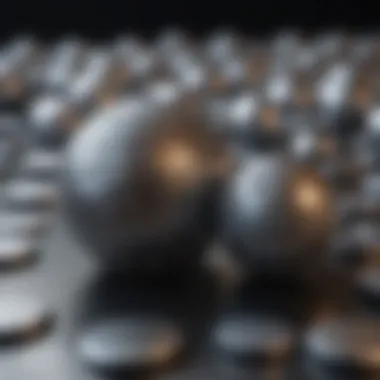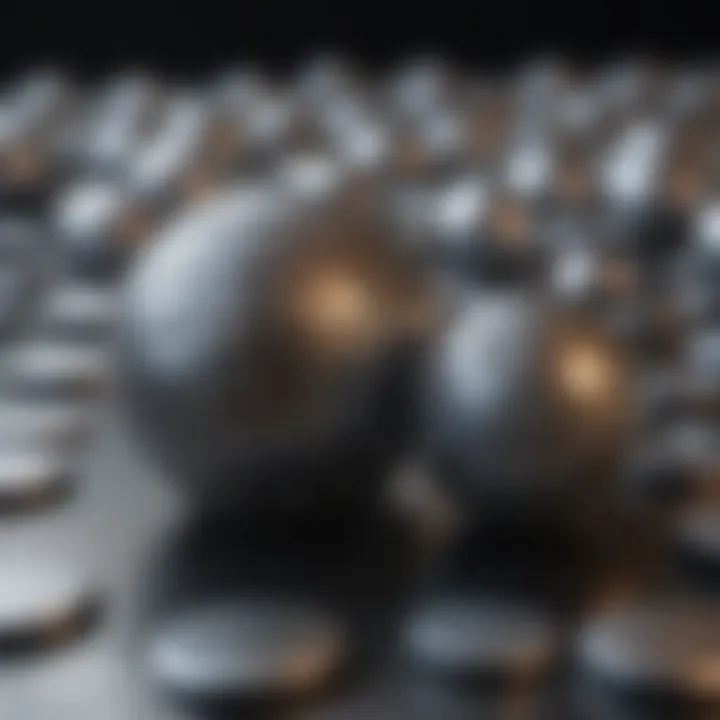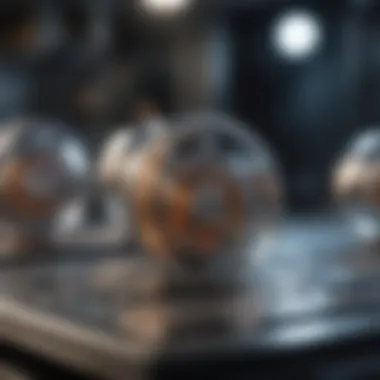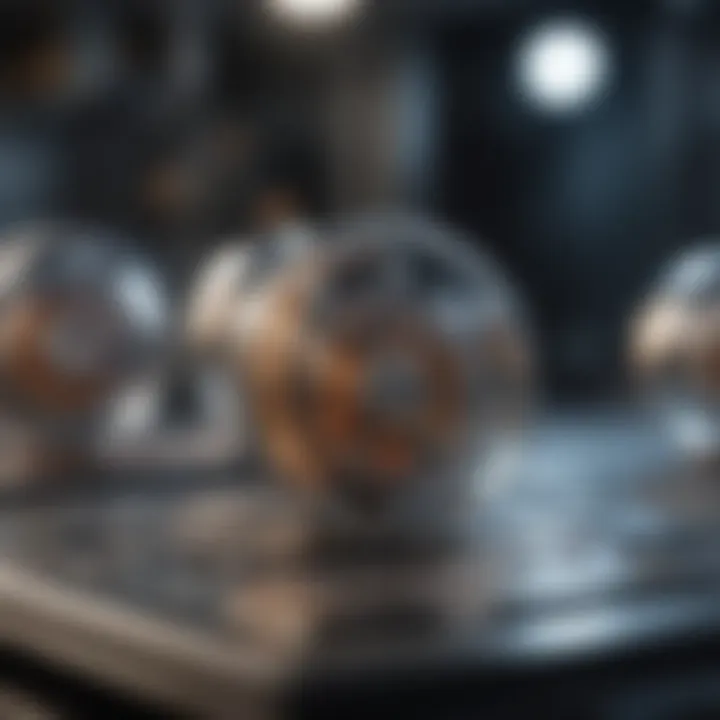The Impact of Shape Memory Alloys in Abdominal Medicine


Intro
The advent of shape memory alloys (SMA) has reshaped how we approach medical technology, particularly in abdominal applications. From the first attempts at using metallic materials for surgeries, the evolution toward SMA stands as a testament to innovation in the medical field. Shape memory alloys are unique materials that can return to a predetermined shape when exposed to specific stimuli, like heat. This distinct property makes them invaluable in various medical scenarios, especially when tailored for intricate bodily applications.
Key Concepts and Terminology
Definition of Key Terms
Understanding SMA begins with grasping some foundational concepts:
- Shape Memory Effect (SME): This is the ability of SMA to revert to a fixed shape upon heating.
- Superelasticity: This phenomenon allows the material to deform elastically and recover its shape upon unloading, even at room temperature.
- Biocompatibility: Refers to the ability of the alloy to co-exist with the human body without eliciting adverse effects.
Concepts Explored in the Article
This article investigates several dimensions of SMAs in abdominal applications, including:
- The historical context of shape memory alloys in medicine.
- Their unique material properties that contribute to advancements in surgical techniques.
- Current applications, from stents to surgical tools tailored specifically for the abdominal region.
- Future directions for SMA development, anticipating their further integration into medical practices.
Preamble to Shape Memory Alloys
In the realm of advanced materials, shape memory alloys (SMAs) hold a unique place. They offer properties that challenge conventional understanding of metals and materials science, blending practical application with sophisticated engineering. This section sets the tone for a deeper exploration of SMAs, laying the groundwork for their significance in abdominal applications.
The importance of SMAs, particularly in medical fields, cannot be overstated. With their ability to return to a pre-defined shape when stimulated by changes in temperature, SMAs create opportunities for innovation in surgical instruments and implants. Their unique characteristics permit minimally invasive procedures, resulting in benefits such as reduced recovery times and improved patient safety. Understanding the materials behind these advancements is crucial for students, researchers, and medical professionals alike.
Defining Shape Memory Alloys
At its core, the definition of shape memory alloys is relatively straightforward. SMAs are metallic alloys which demonstrate the ability to undergo a phase transformation, enabling them to 'remember' their original programmed shape. Typically, the most common SMAs are nickel-titanium (NiTi) alloys, known for their remarkable properties.
When an SMA is deformed at a lower temperature, it retains this mechanical change until heated to a particular temperature, at which point it reverts to its initial shape. This shape memory capability can be linked to two unique characteristics: the martensitic transformation, which occurs at lower temperatures where the material is more ductile, and the austenitic transformation, where the material regains its strength and original form upon heating.
Moreover, it is critical to highlight that the applications of SMAs extend beyond just their mechanical behavior. Their biocompatibility makes them particularly attractive for medical uses, as they can be integrated safely into human tissues. For instance, in vascular stents or surgical fasteners, SMAs provide not just mechanical support but also adaptive responses to body temperature, which could be vital in patient-specific treatments.
Historical Development of SMAs
The journey of shape memory alloys began in the 1930s, but it wasn't until the 1960s that their potential was recognized in earnest. Researchers like William J. Buehler and others at the U.S. Navy's Naval Ordnance Laboratory redefined the scope of these materials, revealing their unique thermomechanical properties and adaptability.
Initially, the main interest in SMAs was in military and aerospace applications. However, as the years rolled by, their utility in the medical field began to emerge, particularly when doctors looked for solutions that could align with the body's biophysical requirements. The late 20th century saw a marked increase in the incorporation of SMAs in surgical devices, paving the way for groundbreaking advancements in medical technology.
"Understanding SMAs isn't just a story of materials; it's a story of medical innovation where engineering merges with healthcare for the benefit of patients."
By the early 2000s, the proliferation of shape memory alloys in various medical applications had gained momentum. Today, they permeate different surgical techniques, including treatments in cardiovascular, orthopedic, and even dental fields. This evolution speaks volumes about the intertwined nature of materials engineering and clinical application, a harmony that is essential in advancing modern medicine.
The historical context not only underscores the necessity of pioneering materials like SMAs but also demonstrates the continuous need for research, innovation, and properly understood engineering principles to drive medical technology forward.
Material Properties of SMA
When examining the role of shape memory alloys (SMA) in abdominal applications, understanding their material properties is paramount. These properties directly impact the effectiveness and reliability of SMAs in critical medical settings. The unique characteristics of these alloys—like their thermal properties, mechanical strengths, and corrosion resistance—allow designers and surgeons to innovate and improve patient outcomes significantly.
Thermal Properties
Thermal properties of SMAs have a profound influence on their function. The shape memory effect happens due to a phase transformation that occurs at specific temperature ranges. This nuance is key in abdominal applications, where the body’s interior environment varies considerably. For instance, as a shape memory alloy heats up, it can revert to a pre-defined shape; this is particularly useful in devices that need to expand or contract within body cavities.
In practical terms, when doctors insert these devices at body temperature, they reliably expand to their intended form. The ability to tune these thermal properties through alloy composition is crucial. Manufacturing techniques allow for precise control over these temperature ranges, enabling tailored solutions for various types of surgeries
Mechanical Properties


The mechanical properties of SMAs are equally critical. These materials exhibit remarkable elasticity and strength compared to conventional alloys. Shape memory alloys can withstand significant deformation while maintaining their structural integrity. This means they can endure the stresses of body movements without failing, making them ideal for applications like stents and fixation devices.
SMAs also display a unique fatigue resistance. Unlike typical metals that might weaken after repeated use, these alloys can withstand numerous cycles without significant degradation. It is this very feature that offers surgeons confidence during procedures involving dynamic movements, like in orthopedic applications, ensuring the devices perform reliably long-term.
"The inherent ability of SMA to maintain form and function under stress presents a game-changing advantage in surgical applications."
Corrosion Resistance
Corrosion resistance is an often-overlooked yet vital characteristic of SMAs, especially in abdominal applications where exposure to bodily fluids is inevitable. Notably, certain SMAs are designed to resist degradation in saline environments, prolonging the life of implants and reducing the risk of catastrophic failure post-implantation.
This resistance is not merely an incidental feature; it is a deliberate choice in the materials' composition. Alloys like Nitinol—primarily composed of nickel and titanium—are adept at resisting corrosion simply due to their chemical stability. This property significantly decreases the likelihood of creating ions that could provoke negative biological responses, making SMAs a safer option for patients that require implanted devices.
In summary, the material properties of shape memory alloys—spanning thermal responsiveness, mechanical strength, and corrosion resistance—grant them a unique advantage in abdominal applications. Their capabilities allow for innovative medical solutions that enhance patient care and outcomes.
SMA Applications in Medicine
Shape memory alloys (SMAs) have made quite a splash in the medical field, especially regarding abdominal applications. Their unique properties not only enhance surgical practices but also improve patient outcomes. In this section, we will explore the various applications of SMAs in medicine, shedding light on their significance and contributions to surgical advancements.
Surgical Instruments
Applications in Minimally Invasive Surgery
Minimally invasive surgery is a game changer in the medical world. It allows surgeons to perform complex procedures through small incisions, which translates to decreased recovery times and less post-operative pain for patients. SMAs play a pivotal role here. Because of their ability to change shape in response to temperature variations, these alloys can be molded into intricate designs.
This flexibility means they fit into tight spaces without compromising their structural integrity. Their heat-activated properties mean that once inserted, they can expand or contract based on the surgeon’s requirements. It's like having a toolbox at your disposal that adapts to your needs.
The standout feature of these SMA applications is their ability to reduce trauma to surrounding tissues. This is crucial in delicate abdominal surgeries, where excess pressure or damage can lead to longer healing times or complications.
In summary, the key reasons why SMAs shine in minimally invasive surgery are their:
- Reduced tissue damage
- Enhanced precision
- Faster recovery times
Innovations in Surgical Design
When it comes to surgical design, innovation is the name of the game. SMAs have sparked a wave of creativity in the design of surgical instruments. From scissors that conform to body curves to forceps that apply consistent pressure without harming delicate tissues, the possibilities are vast. Their unique ability to revert to a previous shape when heated has simplified many traditional surgical processes.
One significant innovation is the development of self-expanding stents made from SMA. These stents can change their size to fit various sized arteries, making them effective in treating obstructions. This self-adjusting characteristic is particularly beneficial for individual patient needs.
However, there are considerations to keep in mind. The production costs and niche usage can be potential drawbacks. But despite the challenges, the flexibility and precision, which SMAs introduce, elevate them as essential tools for surgical proficiency.
Stents and Vascular Devices
The incorporation of SMAs in stents and vascular devices has revolutionized the approach to treating vascular diseases. Traditional stents often face challenges with biocompatibility and adaptability to patient-specific anatomical differences. SMAs, however, offer a solution with their inherent ability to adapt to body temperature and expand or contract as necessary.
Moreover, these devices can provide better blood flow dynamics, promoting healing and reducing the risk of complications over time. The innovative designs incorporating SMAs make the devices less prone to thrombosis, a significant risk with traditional materials. Thus, their application in vascular devices highlights a fundamental shift toward more patient-centric medical solutions.
Orthopedic Uses
SMAs are not only limited to vascular applications. Their versatility extends into orthopedics, particularly for bone fixation. They have emerged as significant tools for enhancing surgical interventions.
Advancements in Bone Fixation
In the realm of bone fixation, SMAs serve a dual purpose. They can provide both stability and responsiveness as the surrounding tissue heals. A notable characteristic in SMA bone implants is that they can adjust their stiffness based on temperature fluctuations, which is particularly helpful during the healing phase. This adaptability aids in minimizing stress shielding around the bone; instead of remaining rigid, the implant can allow for a natural, gradual return to full mobility.
This feature is attractive not only for improving recovery times but also for ensuring the longevity of the implants. However, the complexity of fabricating these devices can be a hurdle in widespread adoption.
Patient Case Studies


Real-world applications illustrate the effectiveness of SMAs in orthopedics. Patient case studies document significant improvements in recovery times and mobility. For instance, individuals who received SMA implants for bone fixation typically reported less pain and increased functionality compared to those with traditional implants.
Such evidence reinforces the potential of SMAs to transform ordinary procedures into extraordinary outcomes, underlining their efficacy in orthopedic applications.
Advantages and Limitations of SMA
The role of shape memory alloys (SMA) in medicine is pivotal, particularly within abdominal applications. Understanding the advantages and limitations of SMAs offers insights into their practical use and guides researchers, engineers, and medical professionals toward informed decisions about their implementation.
Benefits in Medical Applications
SMA technology presents remarkable benefits that position it as a frontrunner in various medical applications:
- Biocompatibility: SMAs demonstrate compatibility with human tissue, minimizing adverse reactions in patients. This characteristic is crucial for implants and devices that remain in the body for extended periods.
- Adaptability: The ability of SMAs to change shape in response to temperature is a game changer. For instance, stents can expand at body temperature, adapting seamlessly to the surrounding tissue. This adaptability enhances patient comfort and device efficiency.
- Minimally Invasive Techniques: Instruments made from SMAs enable surgeons to perform procedures through smaller incisions, which results in quicker recovery times and reduced risk of infection. Procedures like laparoscopic surgery have significantly benefitted from SMA technology.
- Reliability and Precision: The predictable behavior of SMAs under specific conditions ensures they can be relied upon for critical tasks in surgery and treatment. This reliability builds trust among healthcare providers and patients alike.
Challenges in Implementation
Despite their exceptional benefits, certain challenges hinder the widespread adoption of SMAs in medical applications.
Cost Considerations
One notable aspect of cost considerations in the use of SMAs is their manufacturing expense. The process to produce high-quality SMA products can be more costly than non-SMA materials. This feature often translates to higher prices for medical devices, which can limit access for healthcare facilities, particularly in economically disadvantaged areas. Additionally, the complexity involved in sourcing materials that meet the required standards can also contribute to the overall cost. While the initial investment may seem high, it is essential to recognize that the long-term benefits—such as reducing complication rates and improving recovery—can justify the expense. The key characteristic of cost considerations lies in balancing high upfront costs with potential savings in improved patient outcomes.
Material Availability
Material availability poses another challenge in the deployment of SMAs. The raw materials required to create these alloys are not as commonly accessible as traditional metals used in medical devices. Some SMAs rely on specific compositions, which can lead to supply chain issues if the materials are unavailable or too costly during certain market conditions. This limitation impacts production timelines and may affect the scalability of manufacturing processes. The unique feature here is that while many manufacturers strive to find alternative materials or develop new, more abundant alloys, dependency on niche materials can stall advancements in SMA technology. Ultimately, understanding these challenges allows for better preparation and strategizing within the field of medical applications.
Manufacturing Processes for SMA
The manufacturing processes behind shape memory alloys (SMAs) are as crucial to their application as the alloys themselves. Understanding these processes not only illuminates how SMAs are made but also reveals the benefits and challenges that come with their production. As we delve deeper, we find that both alloy production techniques and shaping and treatment methods play an instrumental role in ensuring that these materials achieve their functional capabilities.
Alloy Production Techniques
When it comes to producing SMAs, alloy production techniques form the backbone of their successful application in medical contexts. The primary methods include
- Arc melting: This involves melting metal components in a vacuum or inert atmosphere, ensuring purity and precise control over the alloying process. It is particularly effective for achieving the unique compositions needed for specific SMA characteristics.
- Powder metallurgy: This method utilizes metal powders to form alloys and can offer uniform properties throughout the material. The powders are compacted and then sintered, creating a dense structure with excellent mechanical properties.
- Shape-casting: Here, molten metal is poured into molds to form specific shapes before being cooled and solidified. This technique is commonly used to create components that need to fit precisely within surgical devices.
Each of these methods has distinct benefits and considerations. While arc melting produces highly pure alloys, it can be time-consuming. On the other hand, powder metallurgy allows for more complex shapes but may involve higher costs.
Shaping and Treatment Methods
After the alloy production, shaping and treatment methods dictate the final form and performance of the SMA. The two key aspects include:
- Hot working: This involves deforming the SMA at elevated temperatures, enhancing ductility and allowing for complex shaping. Hot working not only improves the material's microstructure but also optimizes its mechanical properties.
- Heat treatment: A critical process that influences the SMA's ability to remember its shape. By subjecting the material to controlled heating and cooling cycles, manufacturers can manipulate the phase transformations that occur in SMAs. The outcome is a material that can return to its original shape under specific conditions, which is particularly advantageous for medical applications such as stents or surgical tools.
The combination of these shaping and treatment methods leads to enhanced mechanical resilience and appropriate biomechanical compatibility, which is paramount for ensuring successful integration into the human body.
"The manufacturing process of SMAs is not mere technicality; it is the foundation upon which the remarkable functionalities of these materials are built."
In summary, the manufacturing processes of shape memory alloys are integral to their effectiveness in abdominal applications. With a diverse range of manufacturing techniques, each step—from alloy production to shaping and treatment—contributes to the quality and reliability of SMAs in medical environments. By understanding these processes, one can appreciate the intricate relationship between material science and surgical innovation.
Clinical Outcomes of SMA Implantation
The use of shape memory alloys (SMA) in medical applications, particularly within the realm of abdominal surgery, has brought about significant transformations in clinical practices. Understanding the clinical outcomes of SMA implantation is vital for several reasons. Firstly, it sheds light on how effectively these materials integrate with human physiology, influencing both recovery times and long-term health. Secondly, it provides insight into the safety and efficacy of SMAs, critical elements that shape their acceptance and usage in medical procedures.
When considering SMA implants, one must evaluate several key aspects, such as patient recovery times, the potential for complications, and the durability of these materials in the dynamic environment of the human body.
Furthermore, the integration of SMA into surgical practices has opened doors to more sophisticated techniques, enhancing patient care and outcomes.


Patient Recovery Times
Recovery times post-SMA implantation vary and are influenced by numerous factors such as the type of procedure, the individual’s overall health, and the specific characteristics of the SMA used. Studies suggest that patients with SMA implants often experience reduced recovery intervals compared to traditional implants.
Several factors contribute to this phenomenon:
- Less tissue trauma: The properties of SMA allow for less invasive surgical techniques, resulting in reduced damage to surrounding tissues.
- Biocompatibility: SMAs exhibit favorable interactions with body tissues, promoting quicker healing.
- Adaptive functionality: The unique ability of SMAs to adapt to body temperature and stress can lead to improved functionality in the implantation site.
These factors illuminate why many patients report a faster return to normal activities after procedures utilizing SMAs. For example, in laparoscopic surgeries where SMA devices are employed, surgeons note that patients can often leave the hospital sooner and may return to work within days instead of weeks.
"The adaptability of shape memory alloys is not just a material property; it's a bridge to facilitate faster healing and restoration of quality of life for patients."
Long-term Efficacy and Safety
When discussing long-term efficacy and safety of SMA implants, the conversation pivots towards two critical components: performance over time and any associated risks. Clinical data reveals that when implanted, SMAs tend to retain their shape and function effectively, proving advantageous in applications such as stenting and fixation in orthopedic contexts.
- Performance over time: Studies show a consistent efficacy of SMA devices, with a significant number of patients reporting sustained improvement in their condition years after implantation. The material resilience ensures that the integrity of devices is maintained even in the challenging environment of the human body, where stressors can easily compromise lesser materials.
- Associated risks: However, as with any medical device, there are risks involved. Some patients experience complications such as allergic reactions or issues related to improper fit. The long-term study of these effects remains crucial. Continuous monitoring and follow-up are vital to ensure that the implant is functioning as intended without adverse effects.
Future Directions in SMA Research
Research focusing on shape memory alloys (SMA) is crucial for pushing the boundaries of their application, particularly in the context of abdominal medicine. As technology evolves at a breakneck pace, so too does the need for SMA that meets the challenges posed by modern medical demands. Future research can enhance the versatility and performance of SMAs, ultimately improving surgical techniques and patient care. One of the key benefits includes tailoring materials for specific medical needs, which holds potential for more effective treatments and reduced recovery times.
Innovative Applications in Healthcare
Looking ahead, the innovative applications of SMA in healthcare are set to expand significantly. These materials have already shown promise in various areas, but ongoing research may yield breakthroughs that optimize their properties and functionalities.
- Advanced Stents: With enhanced flexibility and biocompatibility, future SMA stents could better navigate the complex vascular structures of the human body, providing a support system that adapts to changes in blood flow or vessel tension.
- Smart Surgical Devices: Imagine surgical instruments embedded with SMA that react to body temperature or pressure, adjusting stiffness accordingly. This could revolutionize minimally invasive surgeries, making them safer and more efficient.
- Temperature-Sensitive Drug Delivery: Researchers could develop SMA systems that respond to body heat to release medication at precise times, improving therapeutic outcomes and patient compliance.
This potential is exciting, as SMA can bridge the gap between mechanical engineering and medical needs, ultimately leading to patient-centric solutions.
Regulatory Considerations
As the landscape of SMA applications evolves, regulatory considerations will play a pivotal role in bringing innovations to market. With any new materials or devices aimed at medical use, the regulatory framework must adapt to ensure safety and efficacy.
- Compliance with Standards: Future SMA devices must comply with existing regulations, such as those outlined by the FDA or equivalent bodies in other countries. These regulations ensure that new applications do not compromise patient safety.
- Preclinical and Clinical Testing: Rigorous testing is essential. Future studies should emphasize well-structured preclinical phases and extensive clinical trials to ascertain the long-term safety and effectiveness of SMA-based devices.
- Ethical Considerations: As innovations emerge, ethical considerations must not be overlooked. This includes patient consent regarding experimental therapies or treatments, ensuring patients are well-informed.
In essence, future advancements in SMA technology will hinge on thoughtful regulatory approaches that streamline the path from concept to clinical application without sacrificing safety or quality.
"The future of SMA in healthcare is not just about innovation; it's about ensuring that innovation occurs within safe and ethical boundaries."
Combining innovative applications with proactive regulatory measures will enable smoother transitions and enhanced trust in SMA technologies.
Culmination
The significance of shape memory alloys (SMA) in abdominal applications cannot be overstated; these materials stand at the forefront of modern surgical technology, revolutionizing how procedures are performed and patient outcomes measured. In this article, we have traversed an expansive landscape, highlighting how SMAs, with their unique properties, foster innovations in medical practice.
Summary of Findings
Throughout the discussion, we explored the fundamental aspects that make SMAs invaluable in abdominal surgeries. Notably:
- Unique Material Properties: SMAs possess the remarkable ability to 'remember' shapes, transforming when exposed to a specific temperature. This feature enables precise deployment in medical settings, particularly in minimally invasive surgeries that require adaptable devices.
- Clinical Applications: We shed light on various uses, from stents that expand in response to body temperature to orthopedic applications that provide optimal bone fixation. Each application underscores the versatility of SMAs, catering to diverse medical needs.
- Advancing Patient Care: The shift towards SMA technology correlates with improved recovery times and increased safety for patients, leading to a marked enhancement in clinical outcomes. The benefits ripple through the entire healthcare system, from reduced hospital stays to lower rates of complications post-surgery.
These findings signify a pivotal shift in surgical technology, aligning with both engineering advancements and clinical necessities.
Implications for Future Research
As we look forward, the future research directions surrounding SMAs hold tremendous potential not just for improving existing technologies but pivoting toward innovations yet unimagined. Considerations include:
- Innovative Applications: Future studies may delve into novel applications of SMAs in fields beyond conventional surgery, perhaps extending to robotics in healthcare or advanced biomaterials for tissue regeneration.
- Regulatory Frameworks: As SMA technology evolves, so too must the regulatory landscapes governing these materials. Ongoing dialogue between researchers, manufacturers, and regulatory bodies will be crucial in navigating this complex terrain to ensure patient safety and efficacy of novel devices.
- Biocompatibility and Performance: Continuous exploration into the long-term performance and biocompatibility of SMAs will inform both manufacturing practices and clinical outcomes. Researchers could focus on the interactions between SMAs and human tissue to optimize designs further.
"As we embark on this journey of discovering new realms of SMA applications, it's imperative that we maintain a patient-centric focus ensuring better outcomes and safety."
In summary, while significant strides have been achieved with SMAs in abdominal applications, a world of possibilities awaits. Researchers and practitioners alike must remain committed to collaboration and innovation to fully realize the potential of shape memory alloys in improving the landscape of medical technology.







